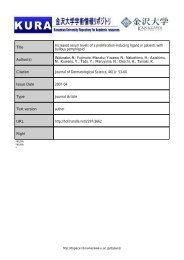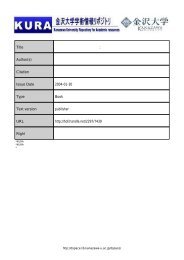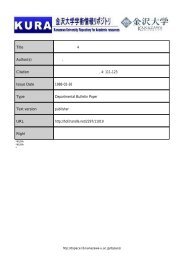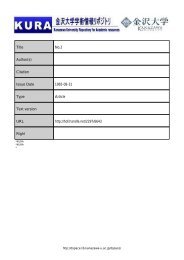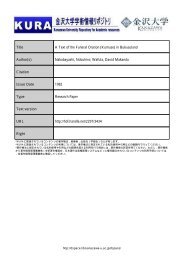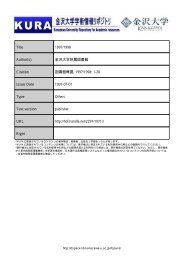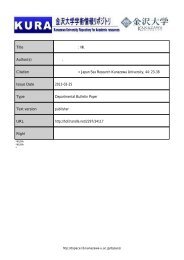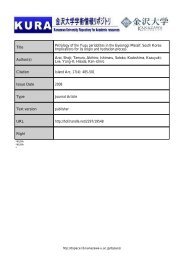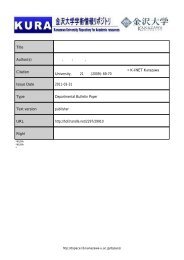Title The Study on Myanmar trade ware:Martaban Jar and ... - 金沢大学
Title The Study on Myanmar trade ware:Martaban Jar and ... - 金沢大学
Title The Study on Myanmar trade ware:Martaban Jar and ... - 金沢大学
You also want an ePaper? Increase the reach of your titles
YUMPU automatically turns print PDFs into web optimized ePapers that Google loves.
<strong>金沢大学</strong>考古学紀要 30 2009, 101-136. <str<strong>on</strong>g>The</str<strong>on</strong>g> study of <strong>Myanmar</strong> <strong>trade</strong> <strong>ware</strong> : <strong>Martaban</strong> jar <strong>and</strong> white dish<br />
height is 66cm, <strong>and</strong> the body diameter is larger than height.<br />
A series of slip butt<strong>on</strong>s was applied around the mouth. 8<br />
pr<strong>on</strong>ged stems, each <strong>on</strong>e was arranged by vertical slip butt<strong>on</strong>s<br />
between two vertical slip lines were around the body. Each two<br />
pr<strong>on</strong>ged stems were between two h<strong>and</strong>les of four sides. <str<strong>on</strong>g>The</str<strong>on</strong>g>se<br />
pr<strong>on</strong>ged stems were arranged inside the frame of two horiz<strong>on</strong>tal<br />
lines from the shoulder to the lower body or waist part.<br />
Black glaze was applied from the mouth to the waist part at<br />
the exterior. <str<strong>on</strong>g>The</str<strong>on</strong>g> glaze colour <strong>on</strong> the design of white slip is<br />
yellowish brown colour. <str<strong>on</strong>g>The</str<strong>on</strong>g> fabric is reddish brown colour.<br />
b. Ac.Dept-2 (Fig.11.b): This glaze jar is also globular shape <strong>and</strong><br />
with short <strong>and</strong> straight mouth. <str<strong>on</strong>g>The</str<strong>on</strong>g> mouth diameter is 27.5cm,<br />
<strong>and</strong> the base is 30cm in diameter. <str<strong>on</strong>g>The</str<strong>on</strong>g> base is larger than the<br />
mouth. <str<strong>on</strong>g>The</str<strong>on</strong>g> body circumference is 229cm or 73cm in diameter,<br />
<strong>and</strong> the height is 61 cm. Its body is also larger than height.<br />
A series of horiz<strong>on</strong>tal slip butt<strong>on</strong>s were around the neck. <str<strong>on</strong>g>The</str<strong>on</strong>g>re<br />
were tube-like four horiz<strong>on</strong>tal loops <strong>on</strong> the shoulder. Pr<strong>on</strong>ged<br />
stems were arranged inside two frames from the shoulder to the<br />
lower body. <str<strong>on</strong>g>The</str<strong>on</strong>g>re were different patterns of vertical slip butt<strong>on</strong><br />
lines such as a pr<strong>on</strong>ged stem with two series of vertical slip<br />
butt<strong>on</strong>s from the shoulder to the upper body <strong>and</strong> single vertical<br />
slip butt<strong>on</strong> lines were around the lower body.<br />
Black glaze is applied from the mouth to the waist part. White<br />
slip was clearly found <strong>on</strong> the part of this glaze around the lower<br />
body. <str<strong>on</strong>g>The</str<strong>on</strong>g> fabric is gray reddish brown colour.<br />
2.3-5 Glazed jar from Twante (Figure 12)<br />
TW.Nijoda: This glazed jar was unearthed from the compound<br />
of Nijoday<strong>on</strong> m<strong>on</strong>astery in Twante. <str<strong>on</strong>g>The</str<strong>on</strong>g> straight mouth diameter<br />
is 27.6cm, <strong>and</strong> the base is smaller than mouth size with the<br />
diameter of 22cm. <str<strong>on</strong>g>The</str<strong>on</strong>g> diameter of body is 95cm <strong>and</strong> its height<br />
is 90cm. It is found that body size is larger than height. <str<strong>on</strong>g>The</str<strong>on</strong>g><br />
black glaze was applied around from the mouth of interior<br />
until nearly to the base part of exterior. However, the most part<br />
is thinly glazed with brown colour. <str<strong>on</strong>g>The</str<strong>on</strong>g> fabric colour is gray<br />
reddish brown.<br />
Each a row with white slip butt<strong>on</strong>s between two horiz<strong>on</strong>tal slip<br />
lines was arranged around the joint of mouth <strong>and</strong> shoulder <strong>and</strong><br />
also around the shoulder. And then, four horiz<strong>on</strong>tal h<strong>and</strong>le loops<br />
were put <strong>on</strong> the four sides. <str<strong>on</strong>g>The</str<strong>on</strong>g>re is <strong>on</strong>e horiz<strong>on</strong>tal projected<br />
line or clay slip line around the lower body or waist part. Three<br />
pr<strong>on</strong>ged stems were arranged <strong>on</strong> four sides. Three pr<strong>on</strong>ged<br />
stems which are arranged by a vertical line composed with slip<br />
butt<strong>on</strong>s between two vertical slip lines is put between other two<br />
vertical single slip lines are <strong>on</strong> four sides. Although this jar has<br />
not yet been dated, it would be presumed during the period of<br />
Hanthawady period about 15th-16th Century.<br />
− 111 −<br />
2.3-6 Glazed jar from Myaungmya Kiln#3 (Figure 13)<br />
<str<strong>on</strong>g>The</str<strong>on</strong>g> sherds of large jars, small glazed bowls, large tubular<br />
supports, spurred supports <strong>and</strong> animal figures were found<br />
in the upper layer of the trench about 30cm from Kiln#3 of<br />
Myaungmya excavati<strong>on</strong>. It would be presumed that the large<br />
tubular supports are the evidences of firing jars in the kilns.<br />
<str<strong>on</strong>g>The</str<strong>on</strong>g>re was found that medium size jar.<br />
<str<strong>on</strong>g>The</str<strong>on</strong>g> most comm<strong>on</strong> cultural find in the trench at the lower levels<br />
was unglazed earthern <strong>ware</strong> which was found at every depth<br />
until ab<strong>and</strong><strong>on</strong>ment of the work about <strong>on</strong>e meter. <str<strong>on</strong>g>The</str<strong>on</strong>g>se were<br />
round bottom jars with a rolled mouth-rim <strong>and</strong> deeply impressed<br />
pattern <strong>on</strong> the upper wall, <strong>and</strong> spouted vessels. A few pieces<br />
of gray st<strong>on</strong>e<strong>ware</strong> jar were also found at this level, <strong>and</strong> a few<br />
pieces of Chinese celad<strong>on</strong> (probably from bowl or plate).<br />
Some pieces of plates <strong>and</strong> bowls with a celad<strong>on</strong> glaze were<br />
found in the area of kiln#3 excavati<strong>on</strong>, but many more were<br />
found <strong>on</strong> the surface elsewhere especially al<strong>on</strong>g the old road.<br />
Although these often had three support scar marks <strong>on</strong> the centre,<br />
no evidence could be found of their producti<strong>on</strong> (Hein, 1999).<br />
a. Myaungmya.K#3-1 (Fig.13.a): This jar with brown colour<br />
natural glaze was excavated from the trench of Myaungmya.<br />
kiln#3. <str<strong>on</strong>g>The</str<strong>on</strong>g> everted mouth is wide <strong>and</strong> with short neck. Three<br />
horiz<strong>on</strong>tal h<strong>and</strong>le loops are around <strong>on</strong> the shoulder. It is medium<br />
size with the diameter of body 45cm, <strong>and</strong> the height is 50cm.<br />
b. Myaungmya-2 (Fig.13.b): This jar is with three horiz<strong>on</strong>tal<br />
h<strong>and</strong>le loops around the shoulder. <str<strong>on</strong>g>The</str<strong>on</strong>g> large body is slightly<br />
tapering to the base. Black glaze was applied until to the waist<br />
part <strong>on</strong> the exterior. Short vertical slip lines were arranged<br />
between the two frames of horiz<strong>on</strong>tal slip lines from the<br />
shoulder to the lower body. It would be with everted mouth<br />
although the mouth part has broken.<br />
c. Myaungmya-3 (Fig.13.c): It is with straight mouth <strong>and</strong><br />
globular shape large body. A row of white slip butt<strong>on</strong>s were<br />
applied around the joint of mouth <strong>and</strong> shoulder. Four horiz<strong>on</strong>tal<br />
loops like tube were around <strong>on</strong> the shoulder. And a vertical<br />
line of slip butt<strong>on</strong>s that was arranged inside two vertical slip<br />
lines was put at the place of each h<strong>and</strong>le between the frame of<br />
tow horiz<strong>on</strong>tal slip lines from the shoulder to the lower body<br />
like other <strong>Martaban</strong> jar. Dark brown glaze was applied from<br />
the moth to the waist part. Fabric is gray yellowish brown. <str<strong>on</strong>g>The</str<strong>on</strong>g><br />
similar style of straight mouth is found from the glazed jars<br />
from Archaeological department of Ministry of Culture <strong>and</strong><br />
from Nijoday<strong>on</strong> m<strong>on</strong>astery at Twante.<br />
2.3-7 <strong>Myanmar</strong> glazed jar from Kyaukmyaung-Sgwebo,<br />
Upper <strong>Myanmar</strong> (Figure 14)<br />
King Alaung-min-tayar brought pris<strong>on</strong>ers of war from<br />
lower <strong>Myanmar</strong> to Shewbo about 1757 after his c<strong>on</strong>quest of




